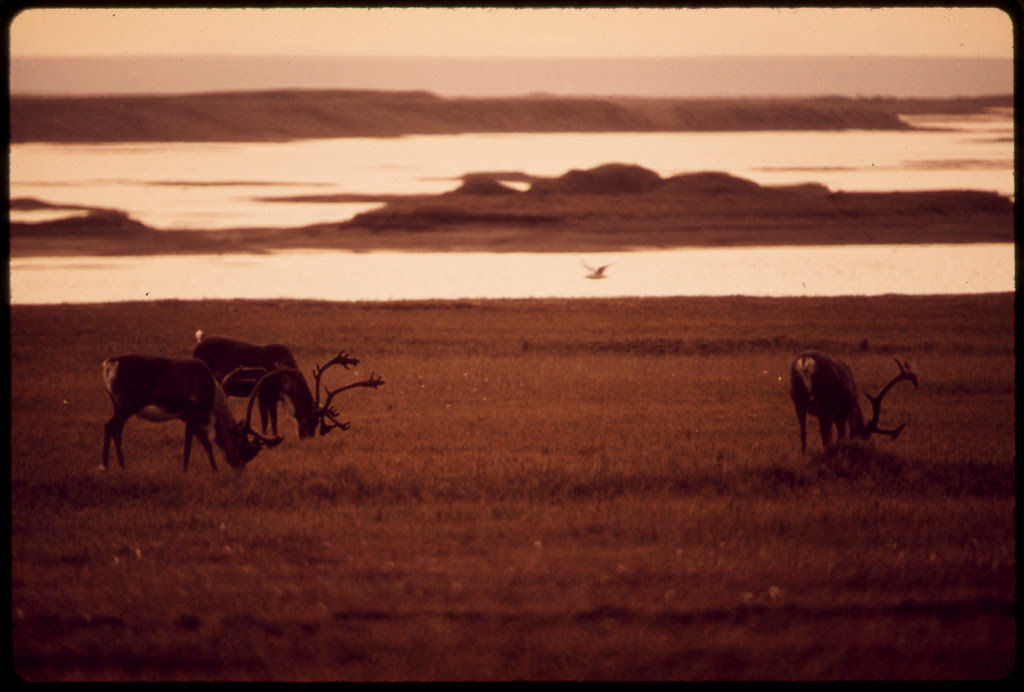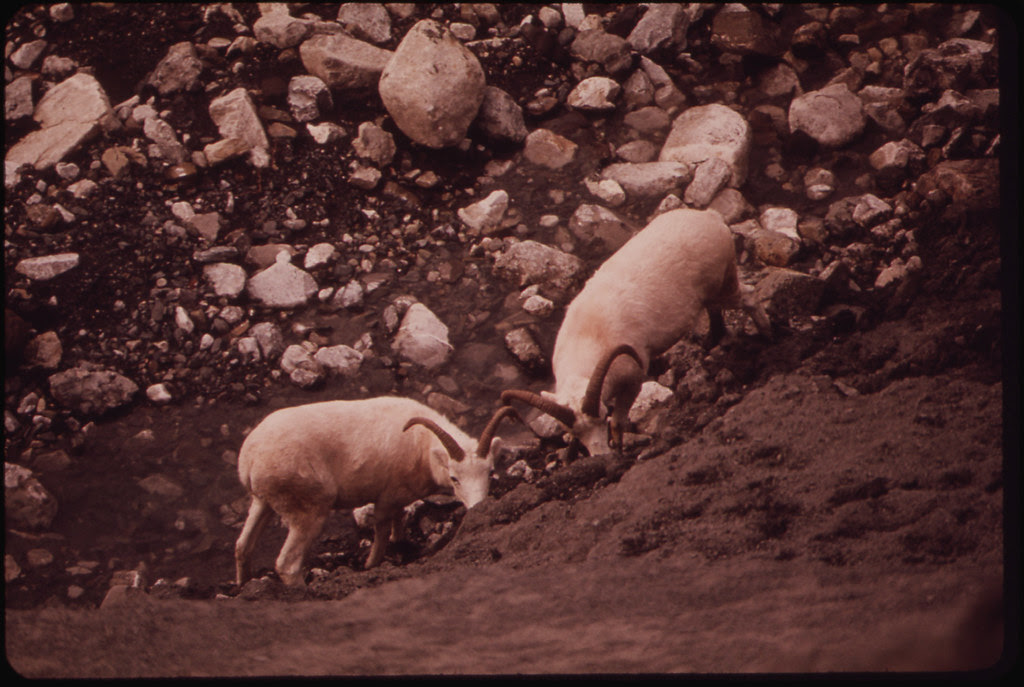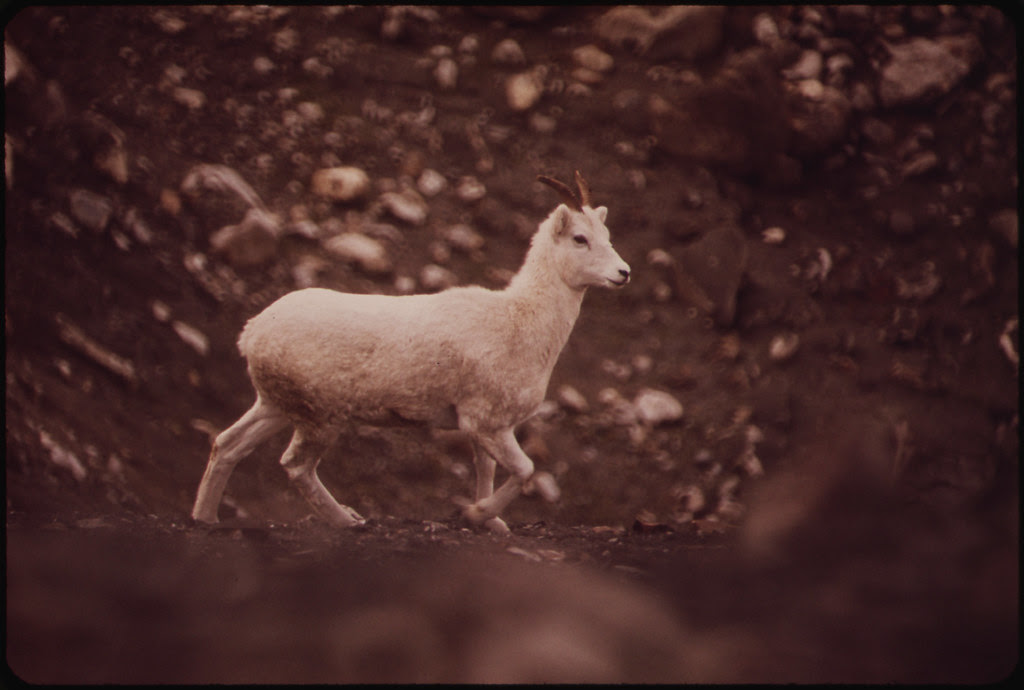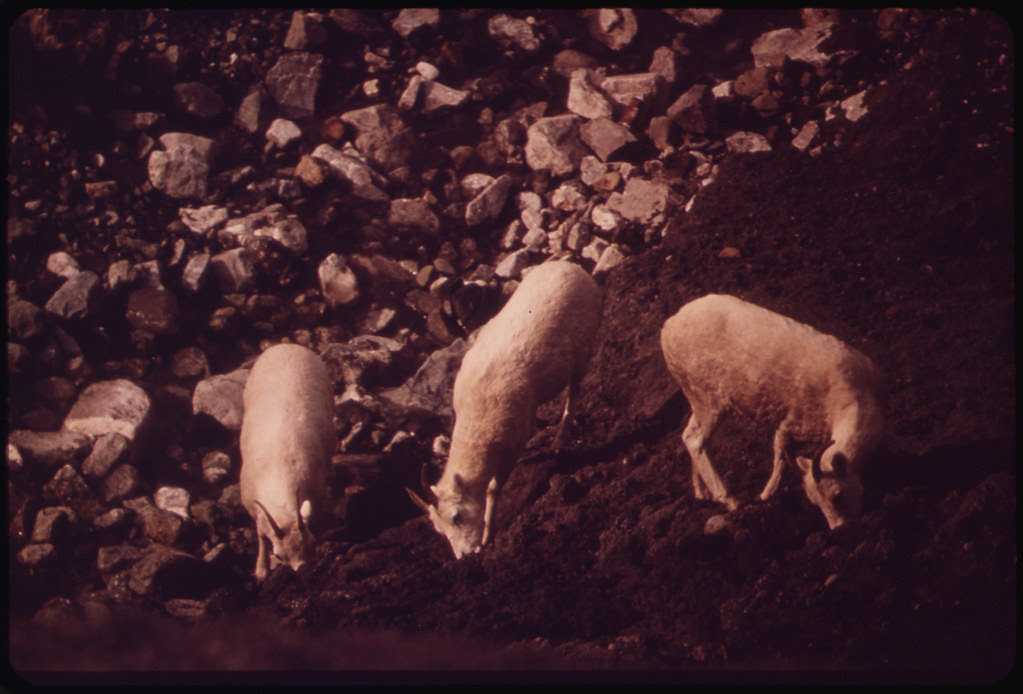
Caribou trot across the tundra, near Prudhoe Bay where the Trans-Alaska pipeline will start
Leaped at the caribou.
My son looked at the caribou.
.
We are looking
My son looked at the caribou.
.
We are looking
at the caribous out in the water
swimming around.
.
Caribou, what have I
done?
.
Caribou, what have I
done?
Joseph Ceravolo (1934-1968): from Ho Ho Ho Caribou, in The Paris Review #44, Fall 1968; reprinted in Spring in This World Of Poor Mutts, 1968


Caribou feed near the Sagavanirktok River. The pipeline will follow the Sag River south some 110 miles.

Caribou graze near the Sagavanirktok River, eight miles east of the north slope site where the Alaska Pipeline will start. The pipeline will follow the Sag River south for the first 110 miles. Gravel from riverbeds will be used for pipeline bed and road.

Caribou graze near the Sagavanirktok River, eight miles east of the north slope site where the Alaska Pipeline will start. The pipeline will follow the Sag River south for the first 110 miles. Gravel from riverbeds will be used for pipeline bed and road.

Caribou in "Alaska Cotton", a plant found in marshy areas along the entire 789-mile route of the pipeline

"Alaska Cotton", found in marshy areas along the entire 789-mile route of the pipeline

Caribou feeding on lichens and moss. The bird is an Alaskan Raven.

Wading shore bird searches out insects in pond. Near Mile 0, Alaska pipeline route.

Wading shore bird searches out insects in pond. Near Mile 0, Alaska pipeline route.

A young female fox near Galbraith Lake Camp, along the planned route of the Trans-Alaska oil pipeline

Young female fox near Galbraith Lake Camp

Day's work done, the Parka Squirrel stands on the bank and surveys its domain, with Franklin Bluffs in background, along the planned route of the Trans-Alaska oil pipeline

A Parka Squirrel, or "Siksikpuk". The Eskimos make their warmest winter parkas from the pelts of the Parka Squirrel

This Parka Squirrel is gathering green grasses to eat during the 9-month winter

This Parka Squirrel is gathering green grasses to eat during the 9-month winter

This Parka Squirrel is gathering green grasses to eat during the 9-month winter

Emerging from its hole, this Parka Squirrel takes a look around for predators -- anything bigger than itself

A Parka Squirrel in the tundra

This Parka Squirrel makes its home among the boulders at the foot of Worthington Glacier. Mile 757, near the Trans-Alaska pipeline route

A pair of young rams, 3-5 years old, descend the west salt lick in Atigun Gorge, four miles from the point where the pipeline will cross the Atigun River

A pair of young rams, 3-5 years old, at the west salt lick in Atigun Gorge, four miles from the point where the pipeline will cross the Atigun River

Young sheep on its way to the west salt lick in Atigun Gorge, four miles from the point where the pipeline will cross the Atigun River

Bolder than its companions, this mountain sheep decided to investigate photographer Dennis Cowals. Photo taken on a bluff above the west salt lick in Atigun Gorge.

Two young sheep cross a hillside on the south side of the Atigun Gorge

A young ram, not yet mature enough to be hunted because he lacks a full 3/4 curl to his horns, approaches a salt lick. Grit and dirt on the high rock ledges have stained his coat a pinkish brown

An adolescent ram struts proudly, showing off before the young females at the west salt lick In Atigun Gorge


A young ram at the west salt lick in Atigun Gorge, near the point where the pipeline will cross the Atigun River

Butt where It itches; this young ram scratches his itching horns on a
Dwarf Alder (about 4 miles east of the designated pipeline crossing in
the Atigun Gorge)

Two young rams nibbling on a Dwarf Alder 4 miles east of the designated pipeline crossing in the Atigun Gorge


Wolf tracks along the shore of a lake near Mile 101. Pump Station 14 will be built atop the hill overlooking this lake. View southeast from north shoreline.

A wolf-chewed caribou thigh bone in the center of the Atigun Valley. View east toward Peak 5430

Atigun Valley. View east toward Peak 5430

Silver-white Wolf in the Atigun Valley. Wolves are found in isolated areas along the entire pipeline route. Being territorial they generally remain within their own valley systems unless the migratory passage of caribou and the need for food take them elsewhere.

White female wolf (Canis lupus) in the Atigun Valley, Alaska. This wolf dens in the riverbank of the Atigun inside the main valley about five miles south of Galbraith Camp. She roams at least twenty miles a day in search of food, from the main valley den into the gorge and then back to the valley proper.



4 comments:
Johnny Horton: North to Alaska, 1960 (unreleased version)
And of course that's exactly what Big Oil did, in the epoch during which Dennis Cowals made this affecting elegiac record.
But of course when the oil runs out, all the highways and pump stations and boomtowns and spike-heel dingbats will remain a lasting part of the landscape.
But... maybe the Dall Sheep, not so much.
How "leaped" moves into "looked"!
Perfect follow on from Murica's First Family, given her record on the environment.
Beautiful photographs. And given the ruin left in the subsequent decades, a necessary project.
Tom,
Couldn't help but recall this
Repent !!!
The animals pictured by Dennis Cowals had no idea what was coming, mercifully for them.
And yes, Black Francis' lyric for "Caribou" (1987) (Manik's link) coincidentally converses in spirit with Joe Ceravolo's "Ho Ho Ho Caribou", writ the following year.
I live cement
I hate this street
It turns to me
I've got lament
This human form
Where I was born
I now repent
Caribou, caribou, caribou
Repent, repent
Post a Comment